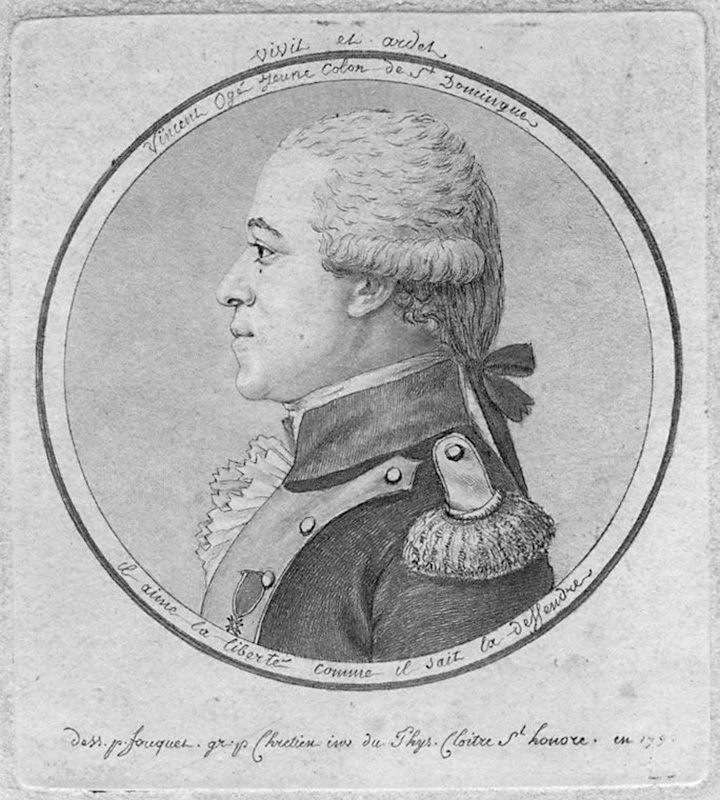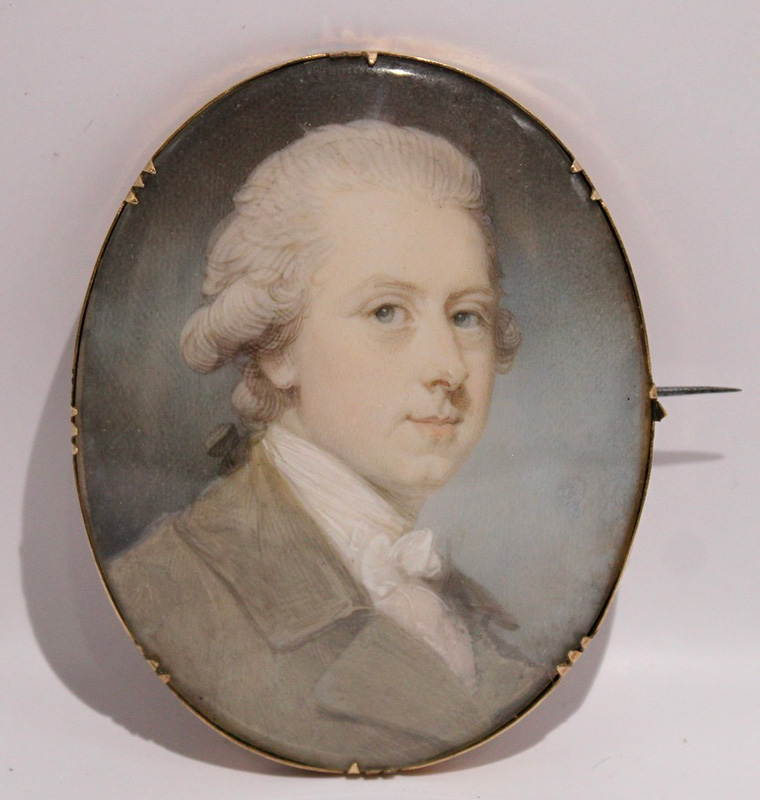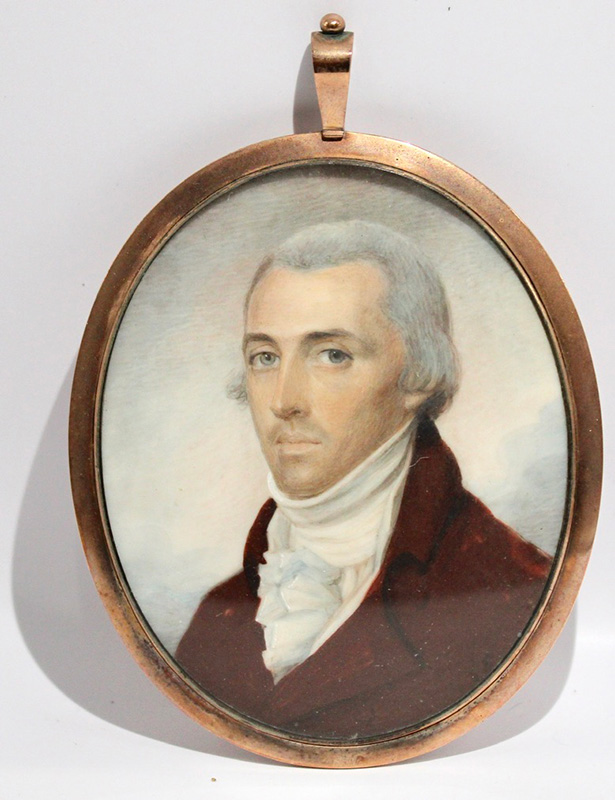Seafaring Portraits in Bermuda and the Atlantic Basin
Click on images to enlarge them and view captions.
by Damiët Schneeweisz
On January 1, 1791, the Bermuda Royal Gazette published an excerpt from a letter by an anonymous writer in Cap Français, Saint-Domingue (present day Haiti). It concerned an uprising in the French colony led by Vincent Ogé (figure 2), a goldsmith, merchant, and the son of a white Frenchman and a free woman of color, who owned a coffee plantation in northern Saint-Domingue. Ogé had advocated for equal voting rights in the colony for free men of color. On the eve of the Haitian Revolution, which would commence mere months later, the possibility of Ogé’s rebellion sparked fears throughout the Caribbean and the Atlantic world. The French Assembly swiftly responded with a reward for Ogé’s head. The excerpt in the Bermuda Gazette begins at this point, for the letter suggests that the reward prompted a daring response from Ogé, who sent his own letter to the Assembly, including “a miniature of himself […] in case any one should offer to them any other head instead of his own.”1
The letter portrays Ogé as an audacious adversary as well as a man carefully attuned to the fashioning of his own image. It was not Ogé but his miniature portrait that traveled widely, likely circulating amongst members of the Assembly as well as in the minds of the readers of Bermuda’s Gazette, who, we will see, would have been aware of both the growing fears for revolution as well as the radical potential of portraiture.
Despite its vast distance from Haiti—Bermuda is located some 900 miles north of the Caribbean—the excerpt finds a parallel between the two islands in the use of the portrait miniature as a portable avatar, able to traverse great passages across land and sea.
Miniatures have long held a great capacity for circum-oceanic movement and engagement. In museum collections, these small portrait-objects have straddled the worlds of decorative and fine art and jewelry. They are difficult to categorize, often painted on sheets of vellum or ivory with watercolors and set with hairwork in oft-bedazzled lockets that could be worn or carried on the body. Materials like ivory and mother of pearl, both protoplastics, were able to withstand the elements better than painting on canvas, wood, or paper, making miniatures particularly suited to the tropical climate of the Caribbean.2 Their small stature also ensured they were not subject to large duty costs or complex transport procedures.3
In my PhD dissertation, I trace the history of the portrait miniature in the Caribbean and the wider Atlantic basin during the long 18th century. I chart the production, use, and value of miniatures in this dynamic region where many were frequently on the move (both by choice and by force) and separated from loved ones. Miniatures served the desire for intimate keepsakes that could preserve one’s own likeness or carry the image of someone dear. Such a geographical shift exposes how the transatlantic slave trade and its exploits lie at the very heart of the development of the miniature, from the sourcing of ivory from elephant tusks to the dissemination of ideas about whiteness.4 It also reveals that, in the Caribbean, people of color, both free and enslaved, were closely involved with the production and dissemination of portrait miniatures as patrons, artists, skilled laborers, and sitters. Like Ogé, they instrumented the miniature in radical, even revolutionary ways.
Although this is the first comprehensive study of the miniature in the Atlantic World, portrait miniatures may be linked to islands in the basin from their earliest Tudor inception. Alexander Marr has identified the sitter for Isaac Oliver’s Man in Flames as William Strachey, the Virginia colonist who shipwrecked in Bermuda, best known today for his account of the disaster that may have inspired Shakespeare’s The Tempest.5 Tantalizingly, Marr proposes that the fire that envelops Strachey on his portrait does not symbolize a man in the throes of romantic passion but rather belies his faithful commitment to the colonial project.6
A century later, it was again a portrait and miniature painter who set the course for American and Bermudan art history. Motivated by George Berkeley’s plan to create a seminar in Bermuda to instruct enslaved and Indigenous Americans, John Smibert agreed to accompany Berkeley as his tutor of the arts. Lesser known than Smibert’s foundational Bermuda Group are his portrait miniatures: his miniature of Samuel Browne, now in the care of a Bermuda collector, was executed in Boston and is often referred to as the first portrait miniature made in America. Although Smibert would never reach Bermuda, he inspired many artists who did, including Joseph Blackburn and John Green.
I traveled to Bermuda to study and document Green’s miniatures in the fall of 2023 with the generous support of a Research Grant from the Decorative Arts Trust. Three of his miniatures remain at the Bermuda National Trust’s Verdmont House, where Green lived and worked from 1774 until his death in 1802. They include a self-portrait and portraits of Sir Howard Trott and Elizabeth Trott, each mounted in a small metal locket that was likely set on a bracelet or worn as a brooch (figure 3). Many questions remain about Green’s practice, including to what extent enslaved people who lived and worked at Verdmont were involved in the making of his portraits directly. Smibert is known to have relied on Cuffee, an enslaved man, to prepare colors in his Boston studio.7
Green was not the only portrait painter on the island. Miniature painters frequently traveled through Bermuda from Europe and the Americas, settling for brief periods of time before continuing onwards. More rooted artists also offered instruction in the arts, training another generation of Bermudan residents. Over 25 portrait miniatures and numerous mourning and hairwork miniatures remain in public collections in Bermuda, and many more survive in private hands. They include particularly skilled examples in the collection of the Bermuda National Trust and the Bermuda Historical Society, such as the portrait of Henry Hamilton, Governor of Bermuda (figure 4), and a miniature of a young John Stowe (figure 5). They hold rich stories, too: for example, a mourning miniature made by Captain John Eveson (figure 6), a Bermudan exiled in Guadeloupe away from his wife and children. Such objects give material form to a complex creole social network of love and loss that connected islands throughout the Caribbean and Atlantic basin.
Documenting these portraits and the stories associated with them took up most of my brief time in Bermuda. I owe my thanks to the Bermuda National Trust, who invited me to lecture and made possible many connections with Bermudan experts and collectors. I hope to return in 2024–25 to catalogue additional objects and share my findings on the island in collaboration with the Bermudan National Trust and the Bermuda National Gallery.
The Decorative Arts Trust has been instrumental in my ability to do this research at every stage: not only in the form of the Research Grant, but also by enabling me to participate in the Museum of Early Southern Decorative Arts Summer Institute as the William C. and Susan S. Mariner Emerging Museum Professional Fellow the year prior, where I honed my fieldwork skills in the context of colonial collections. I am indebted to the Decorative Arts Trust for their continued support of my training and research. My further thanks to the many experts and hosts who kindly shared their expertise and warmth with me in Bermuda.
- The Royal Gazette, The Bermuda Gazette and Weekly Advertiser, 1 January 1791, p. 4. It is possible that the excerpt refers to Ogé’s profile portrait, of which Ogé had 400 copies printed in Paris around 1789.
- Cynthia Kok, “Thinking into Early Modern Mother-of-Pearl, Materiality and Liveliness,” HECA@30, 13 October 2023.
- Viccy Coltman, “Sojourning Scots and the Portrait Miniature in Colonial India, 1770s-1780s,” Journal for Eighteenth-Century Studies 40, no. 3 (2017): 421-441.
- Katherine Fein, “Picturing White Skin on Elephant Tusk,” American Art 36, no. 3 (Fall 2022).
- Alexander Marr, “A Mystery in Miniature: Isaac Oliver, the Virginia Colonists, and the Tempest,” Apollo (September 2020): 20-23.
- Ibid.
- Jennifer van Horn, Portraits of Resistance: Activating Art During Slavery (New Haven: Yale University Press, 2022), 33-8. In Bermuda, enslaved people worked primarily as craftspeople and sailors, and they may have been involved with portraits too.
Damiët Schneeweisz is an Associate Lecturer and PhD Candidate at the Courtauld Institute of Art.
A print version of this article was published in The Magazine of the Decorative Arts Trust, one of our most popular member benefits. Join today!






